What is Student-Focused Coaching (SFC), and how can it help both teachers and students succeed? A widely used, highly effective approach to improving student outcomes, the SFC model connects instructional coaches with teachers so they can work collaboratively to support students using evidence-based practices. This model works because it has a long-term positive impact: instead of providing direct services to students for a limited time, coaches partner with teachers and empower them to provide the best instruction and support for every student.
Field-tested and research-based, the SFC model is the subject of an exciting new book: Student-Focused Coaching by Jan Hasbrouck & Daryl Michel. Today’s post, excerpted and adapted from the book, introduces you to the three key roles in which SFC coaches should engage: Facilitator, Collaborative Problem-Solver, and Teacher/Learner. Discover what each role is and isn’t—and if you think your school could benefit from implementing the SFC model, be sure to check out the book!
The Facilitator Role
What it is:
SFC coaches are engaged in the Facilitator role when they:
- Support the continued success of effective, skillful teachers
- Spend time building the important professional relationships that can get the coaching process started
- Help lead their school, district, or agency toward a commitment to the success of all students by supporting the successful implementation of systems of support, such as leadership teams
What it isn’t:
- A way to “fix” teachers. As Facilitators, coaches should structure their daily work around embracing and modeling collaboration and mutual engagement. It’s about working together to enhance student learning, not seeking out struggling teachers to fix.
- An “assistant” role. As helpful as the Facilitator role can be, it is important that a coach not spend excessive time in this role. Too much time spent doing supportive tasks for teachers can turn the coach into an assistant or quasi-administrator and minimize the impact of coaching for teachers and students.
What it looks like:
Here’s one example of what a Facilitator might do, from Hasbrouck & Michel’s book:
A new third-grade student came to the school just after Thanksgiving. He had an IEP for emotional and behavioral disorders (E/BD) and would receive services from the school’s special education staff. He needed to have a “home” classroom and teacher, however, and highly experienced teacher Diane was the obvious choice. As soon as Diane learned that she would be receiving this new student, she reached out to instructional coach Jan to get some support. Jan was surprised (“Really? Diane needs help?”), but she was also honored that such a skilled teacher would consider her to be helpful.
Together they read through the student’s cumulative folder and special education file. They met with the special education teacher to set up a way to communicate between the classrooms to be sure that both teachers would be providing a consistent message to the student. Jan called the student’s previous classroom and special education teachers to see if they had suggestions about strategies and supports that had previously worked with this student, and she shared this valuable information with Diane. While in the Facilitator role, Jan also incorporated aspects of the other two SFC roles. She connected Diane with professional opportunities (the Teacher/Learner role), and they collaborated on a plan to be proactive for any possible challenging behaviors that this new student might display (Collaborative Problem-Solver). See the next two sections for more on those two roles.
Things went well for the new student, and Diane gave a lot of credit to Jan. At a faculty meeting, Diane spent about 5 minutes sharing how she had reached out to Jan for coaching support and had found the process to be beneficial. This short testimonial helped establish Jan’s credibility in the school and dramatically increased the number of teachers who were now eager and open to receiving coaching services.
The Collaborative Problem-Solver Role
What it is:
SFC coaches are engaged in the Collaborative Problem-Solver role when they
- Work with teachers to address problems in the classroom that may be keeping students from making adequate gains
- Lead the teacher—or a group of teachers—through a systematic, step-by-step problem-solving process
- Provide support, guidance, and next steps as needed when the action plan is implemented by the teacher(s)
What it isn’t:
A fast “magic bullet” for classroom concerns. Simply giving teachers suggestions for quick fixes is often not very helpful, since a quick fix might not be targeted enough and the teacher might not have all the information they need to effectively implement your solution. Use the highly systematic, in-depth SFC Collaborative Problem-Solving Process outlined in the book to address these concerns. This four-step process ensures that solutions fit the problem and have lasting benefits to the students.
What it looks like:
The complete SFC Collaborative Problem-Solving Process for coaching includes these four phases:
Phase 1: The teacher and SFC coach conduct a problem presentation meeting, which usually takes the form of an informal interview. The teacher completely describes the current status of the problem, shares information about the student or students who are the focus of the concern, presents a bit of history about when the problem started, and describes what has been tried so far. The teacher may also provide other details about special services the student is receiving or about the student’s background or family situation.
Phase 2: Working together closely, the teacher and coach achieve four important objectives: 1) accurately defining the problem based on an analysis of concrete data; 2) setting some appropriate, realistic, and achievable goals; 3) developing a targeted action plan (TAP) to evaluate the achievement of those goals; and 4) developing an intervention plan to reach the goals included in the TAP (i.e., who, what, when, where).
Phase 3: For the length of time specified in the TAP, the teacher implements the new teaching strategy, uses additional instructional materials, and sees that the student receives tutoring, or whatever help was specified in the plan. Formative evaluation data that was specified in the evaluation part of the plan should be collected.
It’s important to fully support the teacher in getting the TAP started. This seemingly simple step is a common stumbling block in the real world. Despite the best intentions and commitment to “start the new TAP for James next Monday,” when Monday rolls around, it may turn out that James is absent or the teacher forgot that this was a field trip day, or many other unexpected circumstances. Coaches should check in with the teacher the night before or on the first day of the plan to help support a successful start. If things did not go as planned, then help the teacher do a reset.
Phase 4: The SFC coach and teacher will analyze available data and use the results to decide about next steps. Should the TAP be ended, continued as is, or modified? Collaboratively make this decision by examining each goal separately. If a goal was achieved, the coach and teacher will consider whether they want to end the TAP immediately, phase it out over time, or go back to the problem definition to develop a new goal or two and then a new TAP to address these goals. If a goal was not achieved, the coach and teacher should ask if they want to adjust the goal, eliminate the goal, adjust or modify the TAP, or simply let the TAP run a bit longer (if the student has made progress but has not yet fully achieved the goal).
The Teacher/Learner Role
What it is:
SFC coaches are engaged in the Teacher/Learner role when they
- Provide more traditional professional development and learning (PDL) support to their teacher colleagues by sharing effective, proven strategies
- Support successful implementation of these strategies in the classroom
- Remain grounded in their role as learners by keeping themselves well informed about high-quality research and best practices so they can help their colleagues support students more effectively
What it isn’t:
A chance for the coach to assume a position of power or superior knowledge. Coaches should maintain their position as a true peer colleague of teachers. A coach should never take the position that they are somehow smarter or more skilled than the other teachers, that they have some mystical wisdom to bestow on the colleagues who are “just” classroom teachers, or that they have some level of power and authority beyond that of teacher. The most effective coaches know that they are learners as well as teachers, and their goal is collaborating with teachers as equals for the benefit of students.
What it might look like:
The Teacher/Learner role comprises all the activities that involve planning and directly providing differentiated, sustained, and appropriately targeted PDL opportunities for teachers. This can include:
- Identifying an article, book, or blog that is relevant to classroom instruction and organizing a study group or using a professional learning community (PLC) format for teachers to examine and learn from those materials.
- Presenting workshops or seminars focused on an issue or concern for which a group of teachers would like to have more information and resources (e.g., supporting struggling readers in content classes, learning to identify dyslexia and providing supports for students with dyslexia across the grades, offering resources to support and extend learning with a new math or science curriculum). These workshops or seminars could also be designed to target an area of concern that has been identified by the administrator/supervisor from examining assessment scores or other data sources.
- Participating—alone or with one or more colleagues—in their own PDL, such as by reading current research on instructional best practices or attending webinars, workshops, or conferences.
- Visiting a classroom at a teacher’s request, observing them teaching a lesson, and providing feedback. Coaches should always be open and prepared to offer this kind of valuable service.
For much more on how to master the three key roles of coaching introduced in today’s post, check out the book Student-Focused Coaching, a one-stop guide to instructional coaching in K–12 schools using the SFC model. To help you put the SFC model into action in your school, the book offers practical activities and materials, including application exercises, virtual coaching tips, and more than 20+ pages of downloadable forms.

GET THE BOOK
Student-Focused Coaching
The Instructional Coach’s Guide to Supporting Student Success through Teacher Collaboration
By Jan Hasbrouck, Ph.D., & Daryl Michel, Ph.D.
Stay up to date on the latest posts, news, strategies, and more!
Sign up for one of our FREE newslettersMore posts like this

9 Steps Educators Can Take to Strengthen Their Mentoring Skills
May 25, 2021
10 Ways Your School Team Can Carve Out More Time to Meet and Communicate
November 12, 2019


Write a Comment
Your email address will not be published. Required fields are marked *
Post a Comment